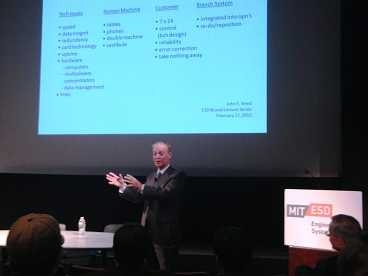John Shepard Reed, current chair of the MIT Corporation and retired chairman and CEO of Citigroup, Inc., spoke yesterday about how the ATM revolutionized personal banking, and the lessons the process holds for systems engineers.
Reed’s talk, part of the Brunel Lecture Series on Complex Systems sponsored by the MIT Engineering Systems Division, focused on his experiences launching a network of ATMs throughout New York City in the 1970s. The effort of designing and manufacturing the complex technology of the banking machines was closely linked to the equally complex social element of the 1.6 million customers and 350 branches involved.
Reed noted that much work in science and engineering now requires a focus on systems. “Whether you’re a scientist or an engineer, in the modern world, you have to understand that you’re going to be working on part of a system,” he said.
This highly expensive, ambitious initiative to deploy ATMs began at a time when there was no real evidence that customers would consistently use them. The project was born out of the thinking that “the electronic dispensing of cash would be a real change agent” in the world of banking, Reed said. This would later prove true, as the appeal of the ATM card opened the door for the credit card, which also allowed customers to access money outside of the traditional bank environment.
Citicorp Systems worked with IBM on much of the technology, addressing software and hardware challenges. Beyond the technology, they needed to address issues regarding how the customer and the ATM would interact effectively with one another — and how to present this new banking option to customers used to receiving service from human tellers. In addition, Reed explained, the design of the machines had to take into account manufacturing efficiency and ease of use.
In the end, Citicorp’s efforts to launch the ATM network were vastly successful and the investment proved worthwhile, breaking even after six months. The company also learned much about its customers. People liked the 24/7 availability of the ATMs, and 40% of ATM traffic happened when the bank was normally closed.
Reed joked that the project was so bold and unwieldy that “it only could have been done by 30-year-olds — anyone older would have been smart enough not to try."
Reed’s talk, part of the Brunel Lecture Series on Complex Systems sponsored by the MIT Engineering Systems Division, focused on his experiences launching a network of ATMs throughout New York City in the 1970s. The effort of designing and manufacturing the complex technology of the banking machines was closely linked to the equally complex social element of the 1.6 million customers and 350 branches involved.
Reed noted that much work in science and engineering now requires a focus on systems. “Whether you’re a scientist or an engineer, in the modern world, you have to understand that you’re going to be working on part of a system,” he said.
This highly expensive, ambitious initiative to deploy ATMs began at a time when there was no real evidence that customers would consistently use them. The project was born out of the thinking that “the electronic dispensing of cash would be a real change agent” in the world of banking, Reed said. This would later prove true, as the appeal of the ATM card opened the door for the credit card, which also allowed customers to access money outside of the traditional bank environment.
Citicorp Systems worked with IBM on much of the technology, addressing software and hardware challenges. Beyond the technology, they needed to address issues regarding how the customer and the ATM would interact effectively with one another — and how to present this new banking option to customers used to receiving service from human tellers. In addition, Reed explained, the design of the machines had to take into account manufacturing efficiency and ease of use.
In the end, Citicorp’s efforts to launch the ATM network were vastly successful and the investment proved worthwhile, breaking even after six months. The company also learned much about its customers. People liked the 24/7 availability of the ATMs, and 40% of ATM traffic happened when the bank was normally closed.
Reed joked that the project was so bold and unwieldy that “it only could have been done by 30-year-olds — anyone older would have been smart enough not to try."






